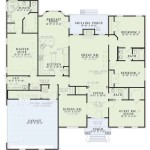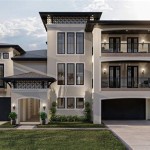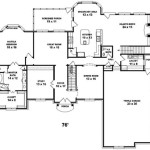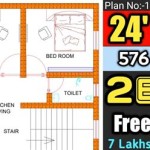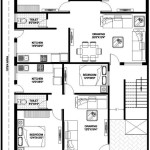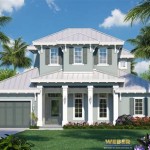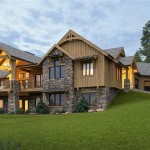House Plans For Views To Front
Designing a house to maximize views, particularly from the front, requires careful consideration of site orientation, architectural style, and interior layout. The goal is to create a dwelling that not only provides comfortable living spaces but also frames and enhances the surrounding landscape. This necessitates a holistic approach, integrating aesthetic principles with practical functionality to deliver a residence that is both visually appealing and highly livable.
Successful house plans that prioritize front views often incorporate large windows, strategically placed balconies, and open floor plans. These elements allow natural light to flood the interior while simultaneously offering unobstructed panoramas. Furthermore, the exterior design should complement the surrounding environment, creating a seamless transition between the built structure and the natural landscape. Factors such as prevailing winds, sunlight exposure, and privacy concerns must also be addressed to ensure the house is both beautiful and functional.
The planning stage is crucial. This includes a thorough analysis of the topography, solar path, and existing vegetation. Understanding these elements will inform the placement of the house on the lot and the orientation of key living spaces. Collaboration with architects, designers, and landscape architects is essential to develop a cohesive design that meets the homeowner's needs and maximizes the potential of the site. The value proposition should be that the initial investment of time and effort results in a home that is a source of constant enjoyment and appreciation for the natural world.
Strategic Window Placement and Glazing
One of the most significant aspects of designing a house for front views is the strategic placement of windows. The size, shape, and location of windows can dramatically impact the visual impact of the view and the amount of natural light entering the home. Large picture windows are often used in living rooms and dining areas to create expansive views, while smaller windows can be incorporated into hallways and bedrooms to provide glimpses of the surrounding landscape without compromising privacy.
The type of glazing used in windows is also an important consideration. Low-E glass, for example, can help to reduce heat gain in the summer and heat loss in the winter, improving energy efficiency without sacrificing views. Tinted glass can also be used to reduce glare and protect furniture from fading. Furthermore, the positioning of windows relative to the sun's path is critical. East-facing windows are ideal for capturing morning light, while west-facing windows may require shading devices to prevent overheating in the afternoon.
Beyond simple window placement, architectural features such as bay windows and clerestory windows can be used to enhance views and natural light. Bay windows project outward from the wall, creating a cozy nook that offers a panoramic view. Clerestory windows are placed high on the wall, allowing natural light to enter the home without compromising privacy. These architectural elements can add visual interest to the exterior of the house while also enhancing the interior living spaces.
The choice of window frames is another factor to consider. Wooden frames offer a classic and natural look, while vinyl and aluminum frames are more durable and require less maintenance. The color and style of the frames should complement the overall design of the house and the surrounding landscape. Minimalist frames can often create a more seamless transition between the interior and exterior, allowing the view to take center stage.
Open Floor Plans and Interior Design
Open floor plans are often used in house designs that prioritize front views. By eliminating walls between living spaces, open floor plans create a sense of spaciousness and allow natural light to flow freely throughout the home. This type of design also makes it easier to enjoy the view from multiple locations within the house. The kitchen, dining area, and living room can be seamlessly connected, creating a central gathering space for family and friends.
The interior design should complement the views and enhance the overall aesthetic of the home. Neutral colors and natural materials can create a calming and inviting atmosphere, allowing the surrounding landscape to take center stage. Furniture should be carefully chosen to not obstruct views and to encourage relaxation and enjoyment of the space. The placement of furniture should also consider the flow of traffic and the functionality of the space.
The use of mirrors can also be a valuable design tool for maximizing views and natural light. Mirrors can be strategically placed to reflect the surrounding landscape, creating the illusion of more space and bringing the outdoors in. They can also be used to bounce light around the room, brightening up dark corners and enhancing the overall ambiance. Attention to detail in the interior design can transform a house into a home that is both beautiful and functional.
Consider the verticality of the space. Lofty ceilings and strategically placed skylights can dramatically increase the amount of natural light and enhance the feeling of openness in the home. Mezzanines and balconies can also be incorporated to offer elevated views and create unique living spaces. The interior design should be carefully considered to create a cohesive and harmonious flow between all the different elements of the home.
The incorporation of natural elements into the interior design can further enhance the connection with the surrounding landscape. Wood floors, stone fireplaces, and indoor plants can bring the outdoors in, creating a warm and inviting atmosphere. These elements can also help to create a sense of continuity between the interior and exterior of the home. The goal is to create a space that is both comfortable and aesthetically pleasing, a sanctuary where occupants feel connected to nature and at peace.
Exterior Design and Landscaping Considerations
The exterior design of a house is just as important as the interior design when it comes to maximizing front views. The architectural style of the house should complement the surrounding landscape, creating a seamless transition between the built structure and the natural environment. The colors, materials, and overall form of the house should be carefully considered to create a visually appealing and harmonious design.
Landscaping plays a crucial role in enhancing front views and creating a sense of privacy. Trees, shrubs, and flowers can be strategically placed to frame the view, screen unwanted elements, and create a sense of depth and dimension. The landscaping should also be designed to complement the architectural style of the house and the surrounding environment. Native plants are often a good choice, as they are well-suited to the local climate and require less maintenance.
The use of outdoor living spaces, such as patios, decks, and balconies, can further enhance the enjoyment of front views. These spaces provide a place to relax, entertain, and connect with nature. The design of these spaces should be carefully considered to maximize views, provide shade and shelter, and create a comfortable and inviting atmosphere. Outdoor furniture, lighting, and accessories can be used to personalize the space and make it feel like an extension of the interior living areas.
Consider the topography of the site when designing the exterior of the house. The house can be designed to blend into the landscape, following the natural contours of the land. This can create a more organic and visually appealing design. Alternatively, the house can be designed to stand out from the landscape, creating a dramatic and striking statement. The choice depends on the homeowner's preferences and the overall design goals.
Sustainability is another important consideration in exterior design. Incorporating eco-friendly materials, such as recycled wood and sustainable bamboo, can reduce the environmental impact of the house. Energy-efficient windows and insulation can help to reduce energy consumption. Rainwater harvesting systems and solar panels can further enhance the sustainability of the house. A well-designed exterior can not only maximize views but also minimize the impact on the environment.
Lastly, ensure that the exterior lighting is designed to enhance the views at night. Soft, strategically placed lighting can highlight architectural features and landscaping elements, creating a warm and inviting ambiance. Avoid excessive lighting that can cause light pollution and detract from the beauty of the night sky. The goal is to create a lighting scheme that is both functional and aesthetically pleasing.

Small House Left Right And Perspective Elevation With Ground Floor Plan Details Dwg File Simple Plans One

Layout Plan Of House With Prospective View And Diffe Section In Autocad File Ground Floor Plans Open

Drawing Of House Plan With Elevation Details In Dwg File Design Plans

29x48 House Plan Design 3d Front Elevation 1392 Sq Ft 6 Bedroom

32x53 3 Bhk Duplex House Plan Front View Design 1738 75 Sq Ft

View Home Sloping Lot Multi Level House Plan 3d 360 Basement Plans Luxury

65x75 House Plan 4 Bedroom Villa Modern Front Design 4875

Right Left Front And Rear Elevation Details Of One Family House Dwg File Open Plans 2bhk Plan Bungalow Design

Left Right Front And Rear View Of Bungalows Dwg File Open House Plans 2bhk Plan Bungalow Design

House Plan Fern View


